
Glamorgan, or sometimes Glamorganshire, is one of the thirteen historic counties of Wales and a former administrative county of Wales. Originally an early medieval petty kingdom of varying boundaries known as Glywysing. Then taken over by the Normans as a lordship. The area that became known as Glamorgan was both a rural, pastoral area, and a conflict point between the Norman lords and the Welsh princes. It was defined by a large concentration of castles.
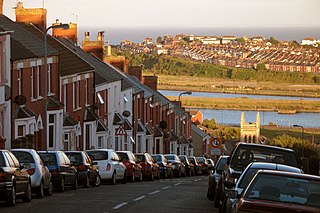
Barry is a town in the Vale of Glamorgan, Wales, on the north coast of the Bristol Channel approximately 9 miles (14 km) south-southwest of Cardiff. Barry is a seaside resort, with attractions including several beaches and the resurrected Barry Island Pleasure Park. According to Office for National Statistics 2016 estimate data, the population of Barry was 54,673.
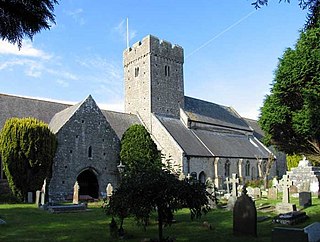
St Illtyd's Church is a church complex in Llantwit Major, Vale of Glamorgan, southeast Wales. It is located at the site of the oldest college in the United Kingdom, Cor Tewdws, which was founded c. 395 AD in honour of the Roman Emperor Theodosius I. It was refounded by St. Illtud c. 508 AD, from whom it derives its name. The current church building was built in the 11th century by the Normans, with portions being rebuilt in the 13th and 15th centuries. The church building is one of the oldest and best-known parish churches in Wales. It is a grade I listed building, or building of exceptional interest, and has been called both the "Westminster Abbey of Wales" for its unique collection of carved stones and effigies, and "the most beautiful church in Wales."
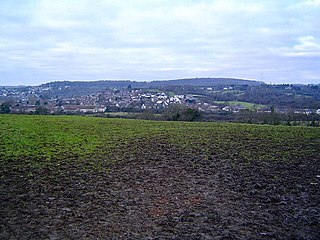
Dinas Powys is a large village and a community in the Vale of Glamorgan in South Wales which takes its name from the ancient Welsh for stronghold, (Dinas) and pagus,(Powys) the Latin word for pagan. The literal meaning, therefore, being, "Pagan Stronghold", referring to Dinas Powys hillfort that dates from the Iron Age. The village is 5.6 miles (9.0 km) south-west of the centre of Cardiff and conveniently situated on the A4055 Cardiff to Barry main road, almost merging with Penarth. It is generally regarded as a pleasant dormitory village for Cardiff's commerce and industry commuters since the city has expanded with widespread development around the Cardiff Bay area.
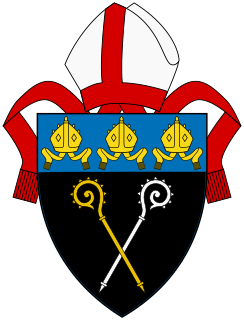
The Diocese of Llandaff is an Anglican diocese that traces its roots to pre-Reformation times as heir of a Catholic bishopric. It is headed by the Bishop of Llandaff, whose seat is located at the Cathedral Church of Saint Peter and Saint Paul in Llandaff, a suburb of Cardiff. It currently covers most of the former Welsh county of Glamorgan, but once stretched from the River Towy to the middle of the Wye Valley.

The Bishop of Llandaff is the ordinary of the Church in Wales Diocese of Llandaff.
St. Brides Major is a village within the community also called St Brides Major in the Vale of Glamorgan in Wales.
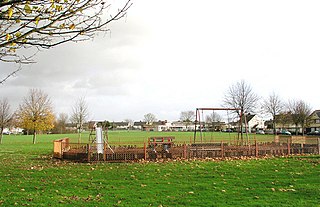
Colcot is a northern district of Barry, Vale of Glamorgan, in the Dyfan ward of South Wales. Dyfan ward is situated in the north west of Barry and its most northern edge is on the green belt of the town. Port Road West runs through the ward and is the main route to Cardiff and Cardiff International Airport in Rhoose. Dyfan benefits from a sports centre and Buttrills recreation field and The Barry Hospital can be found on Colcot Road. It also contains the Colcot Primary School, the Colcot Arms pub, the St David's Methodist Church, Coastlands Family Church, a fish and chip shop/Chinese takeaway, Barry Arts Centre and Merthyr Dyfan Cemetery.

Gibbonsdown, colloquially known as 'Gibby', is a residential area and electoral ward situated in the north east of Barry in the Vale of Glamorgan, Wales. Gibbonsdown borders Merthyr Dyfan to the northwest and Cadoxton to the southeast.
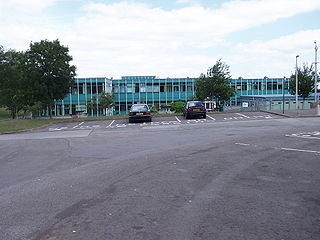
Pencoedtre High School, formerly called the Bryn Hafren Comprehensive School, is located in Merthyr Dyfan on the outskirts of the town of Barry near Cardiff in Wales. It was opened in 1971. Pencoedtre was an 11-19 girls' comprehensive school for approximately 1,300 students. But since 2018 the school has mixed and is now a mixed-sex school. It shares a mixed-sex joint 6th form with Barry Comprehensive School, a boys' school.

Buttrills is a northwestern-central district of Barry in the Vale of Glamorgan, in south Wales. It is also an electoral ward of the Vale of Glamorgan, the population of which taken at the 2011 census was 6,357. The centre of education in Barry in the early twentieth century, Buttrills today contains notable playing fields and Barry Cemetery.

Saint Teilo, also known by his Cornish name Eliud, was a British Christian monk, bishop, and founder of monasteries and churches. He was from Penalun (Penally) near Tenby in Pembrokeshire, south Wales.
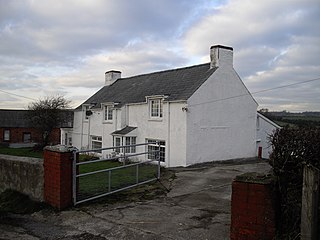
Great Brynhill is a small hamlet and farm in the Vale of Glamorgan in south Wales. It consists little more than a few farms including the Little Brynhill Farm and Thorn Falcon Farm and the Great Brynhill Farm. It is located in the historical parish of Merthyr Dyfan and near Colcot now northern districts of the town of Barry. It is accessed via a lane from Port Road but can also be accessed from Dyffryn along the lane to the New Wallace Farm and Goldsland which lie just to the northeast.

Fagan, also known by other names including Fugatius, was a legendary 2nd-century Welsh bishop and saint, said to have been sent by the pope to answer King Lucius's request for baptism and conversion to Christianity. Together with his companion St Deruvian, he was sometimes reckoned as the apostle of Britain.

Deruvian, also known by several other names including Damian, was a possibly legendary 2nd-century bishop and saint, said to have been sent by the pope to answer King Lucius's request for baptism and conversion to Christianity. Together with his companion St Fagan, he was sometimes reckoned as the apostle of Britain. King Lucius's letter may represent earlier traditions but does not appear in surviving sources before the 6th century; the names of the bishops sent to him does not appear in sources older than the early 12th century, when their story was used to support the independence of the bishops of St Davids in Wales and the antiquity of the Glastonbury Abbey in England. The story became widely known following its appearance in Geoffrey of Monmouth's pseudohistorical History of the Kings of Britain. This was influential for centuries and its account of SS Fagan and Deruvian was used during the English Reformation to support the claims of both the Catholics and Protestants. Geoffrey's account is now considered wholly implausible, but Christianity was well-established in Roman Britain by the third century. Some scholars therefore argue the stories preserve a more modest account of the conversion of a Romano-British chieftain, possibly by Roman emissaries by these names.

Pencoedtre or Pencoetre, also known as Pencoedtre Village, is a northeastern suburb of Barry in the Vale of Glamorgan, Wales. It borders Gibbonsdown to the southwest and Cadoxton to the south. It has developed from a small farming hamlet into an extensive housing estate in recent years. Pencoedtre Wood is one of the largest areas of woodland in the town, and is a Site of Special Scientific Interest. Pencoedtre Park is located between Pencoedtre and Gibbonsdown.

Saint Dyfan is a highly obscure figure who was presumably the namesake of Merthyr Dyfan and therefore an early Christian saint and martyr in southeastern Wales in Roman or Sub-Roman Britain. He is sometimes styled the protomartyr of Wales. The erection of his martyrium was credited to the 6th-century St Teilo. In the 19th century, Edward Williams conflated him with St Deruvian, a figure in the legendary accounts of the baptism of King Lucius of Britain. The discovery of Williams's alterations and forgeries have since discredited this connection. Partially based on this connection, however, the church of Merthyr Dyfan dates his martyrdom to c. 180.
Saint Dyfan was an obscure Welsh martyr and saint.

Barry Town Council is an elected town council serving Barry in the Vale of Glamorgan, one of the largest towns in Wales.




















